Buffalo Steam Yachts Go To War
Twenty-first century multimillionaires have been investing in mega yachts that illustrate their wealth. Early twentieth century multimillionaires did the same, building steam yachts. Buffalo, with its plethora of millionaires, saw its share of steam yachts from the 1880s through the end of World War 1. This is the story of two of them. Descriptions of these is taken from a Buffalo Evening News feature published with photos and illustrations on July 20, 1913; it was the last summer free of war.
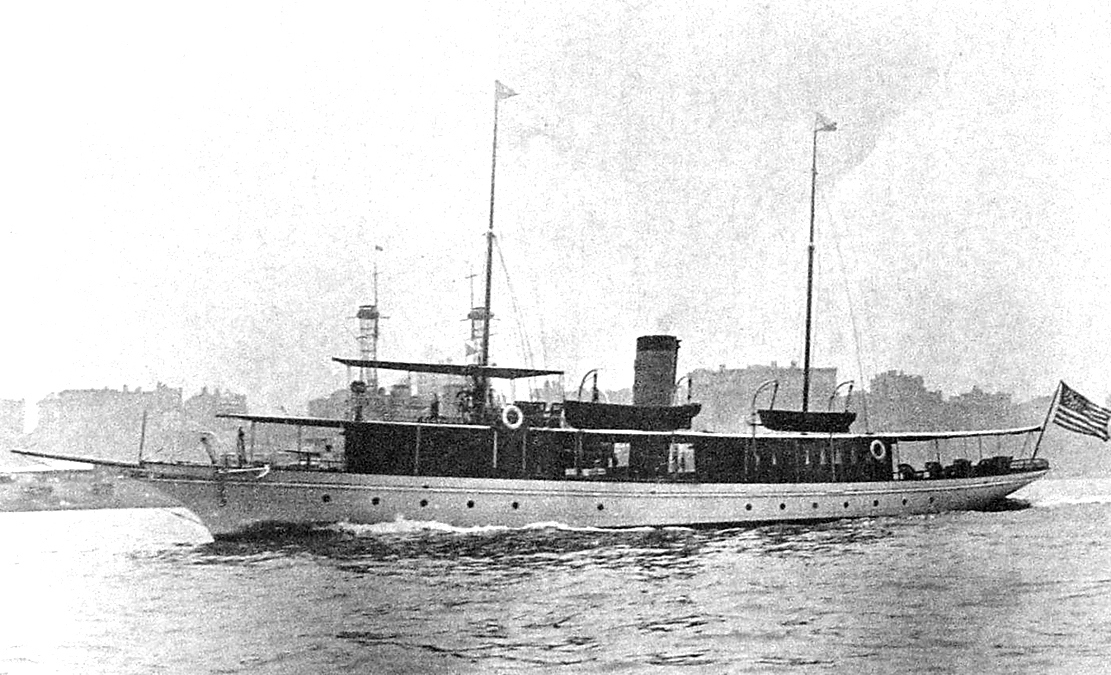
The Elgrudor, Spencer Kellogg's steam yacht
"Thousands of office workers in the tall buildings in the downtown section of the city have often looked from their windows on the upper floors during the hot, sunny afternoons at the trim and spotlessly white pleasure yachts riding gracefully at their anchors on the blue waters of the harbor and wondered, perhaps, if they were comfortable and homey aboard. Few, if any, of all those who have seen them swinging idly at their moorings have any idea, however, of their luxurious and beautifully furnished interiors. It is almost difficult to conceive of such exquisite and neatly decorated cabins in Buffalo harbor, for they contain all that is artistic and pleasing to the eye in color schemes and cozy effects and are equipped with everything necessary to one's comfort. They are the last word in palatial yacht building.
"Perhaps the most familiar of these craft of Spencer Kellogg's yacht Elgrudor, which is generally anchored in the outer harbor off the foot of Georgia Street until the middle of the afternoon when she steams away for Lochevan, Mr. Kellogg's summer home at Derby. The name Elgrudor is composed of the first letters of the names of Mr. Kellogg's four daughters - Elizabeth, Getrude, Ruth, and Doris, which taken together spell Egrudor. Elgrudor is undoubtedly the finest and best equipped yacht of her size on the Great Lakes and the best kept up. On board are seven of the cosiest staterooms imaginable, finished in white enamel and gold and carpeted in red. All are fitted with folding washstands, having hot and cold running water.
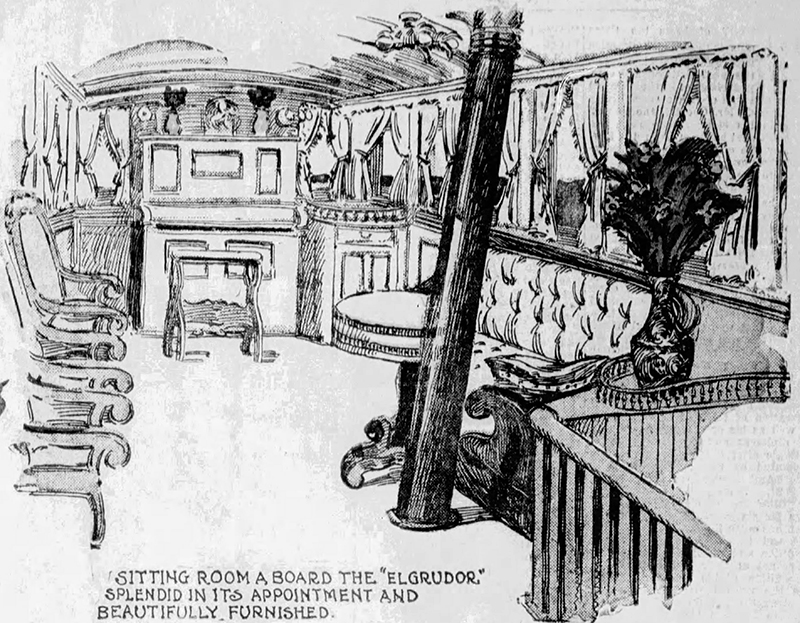
"Perhaps the cutest cabin aboard the Elgrudor is the general sitting room on the main [upper] deck. Finished entirely in satin glossed mahogany with yellow velvet curtains at the windows trimmed with braided gold and a plain unfigured yellow carpet, the lounging cabin is a model of its kind. A ciruclar staircase leading from one corner of the cabin takes one down to the staterooms. At the other end of the room is a Cecelian paino player. It is in this cabin that Mr. Kellogg most often entertains his guests. This is the general living room of the boat while the family is off on a long cruise. All of the comforts to be found in a sitting room of its size in any home ashore are to be had in this little cabin aboard the Elgrudor. There is a sumptuousness and rare good taste displayed in its furnishings that is seldom met with aboard the finest craft that ply out of any harbor, barring none.
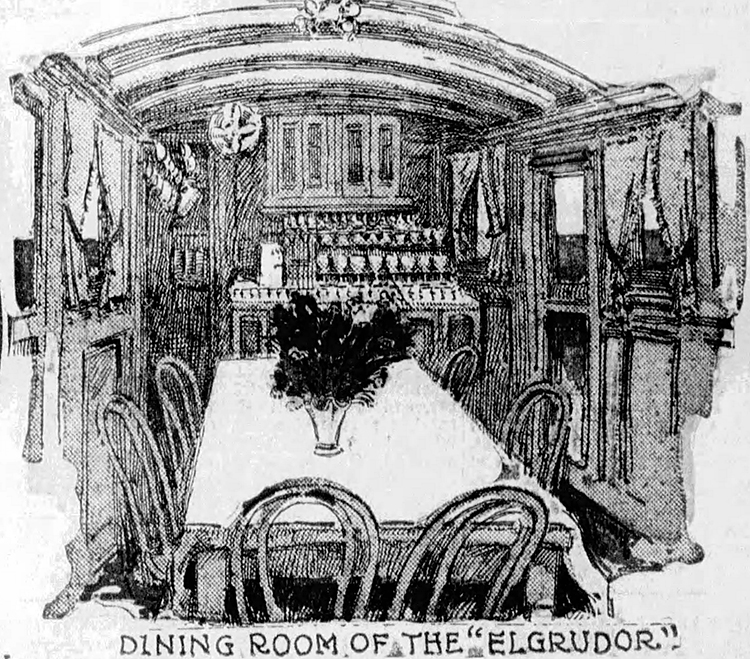 "A visit to the dining room [also on deck] shows an eqully attractive cabin. Here the color scheme is Colonial blue and mahogany red. The mahogany chairs are covered with black Morroco leather, the whole effect beign that of quiet richness and refinement. In the center of the table a vase of flowers and at either end of the little room are the neatly arranged glass cabinets for the china and glassware. Neat mahogany drawers for the silverware and table linen complete the dining room equipment. All that conduces to perfect enjoyment and comfort of those on board this palatial little yacht is there for their use.
"A visit to the dining room [also on deck] shows an eqully attractive cabin. Here the color scheme is Colonial blue and mahogany red. The mahogany chairs are covered with black Morroco leather, the whole effect beign that of quiet richness and refinement. In the center of the table a vase of flowers and at either end of the little room are the neatly arranged glass cabinets for the china and glassware. Neat mahogany drawers for the silverware and table linen complete the dining room equipment. All that conduces to perfect enjoyment and comfort of those on board this palatial little yacht is there for their use.
"The main deck at the stern is furnished with willow chairs and settees in abundance, a center table, and plenty of magazines. Overhead an awning shades those aboard from the hot summer suns. Comfort and ease are the keynote of Egrudor's entire makeup from the passengers' standpoint.
"The Elgrudor has a steel hull and is 132 feet in length overall. She weighs 103 tons and was built at City Island, Brooklyn ten years ago. A 450-horsepower engine furnishes the power, which enables the staunch little craft, which is also said by many marine men to have the finest lines of any yacht on the lakes, to travel anywhere in any kind of weather. She carries the Buffalo Yacht Club flag at her masthead.
"Captain Fred Wiebe, the commander of the Elgrudor, is the only saltwater skipper in charge of a yacht on the Great Lakes and has a crew of 10 Scandanavian sailors, all of whom have seen service on the ocean. Captain Wiebe was born at Sunswvall, Sweden, and has sailed ever since he was twelve years old.
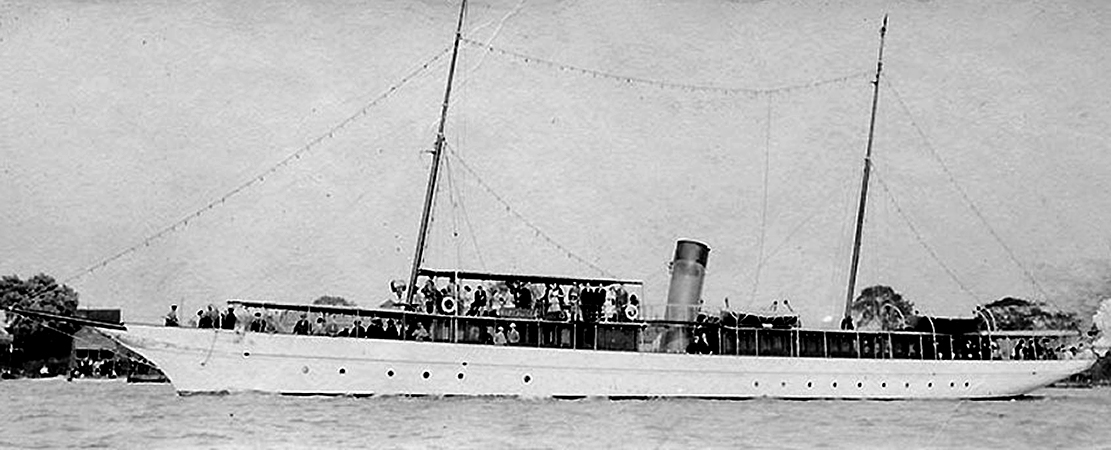
The Mary Alice, William "Fingy" Conners' steam yacht
"Another yacht that is very familiar to lake travelers and those who are acquainted with the Buffalo waterfront is William J. Conners' fine cruiser Mary Alice, named in honor of his daughters, Mary and Alice. The Mary Alice enjoys the distinction of being the largest private yacht on Lake Erie, being 174 feet in length and 18 1/2 feet in breadth. She, too, is a steel craft fitted out with all that is modern in marine architecture. She is well equipped to take long journeys and is frequently seen in many of the upper lake ports and at the Motor Boat Club on Motor Island, of which Mr. Conners is commodore. She flies the Motor Club flag.
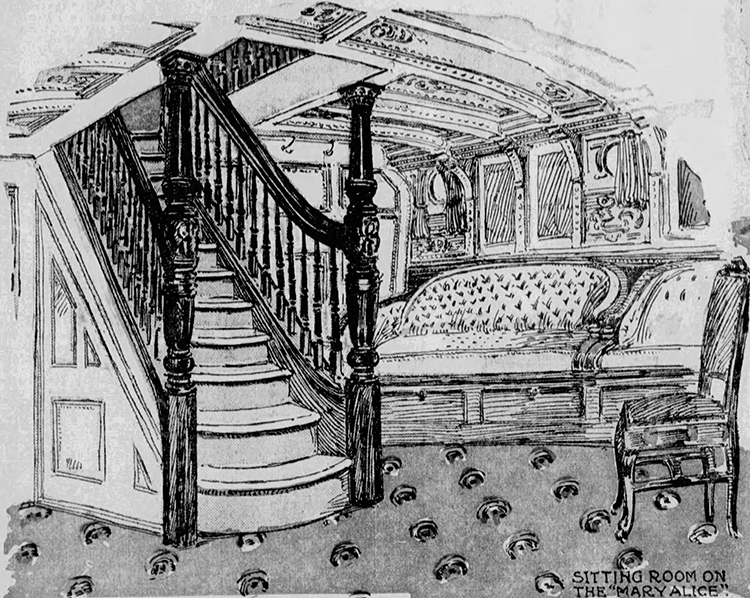
"The general lounging room of the Mary Alice is done in mahogany and ivory colored enamel, relieved by a golden brown trimming, the contrast being rich and pleasing in the extreme. A green velvet carpet wet with tiny red figures completes a cabin the elegance of which would be difficult to match on any private yacht on the Great Lakes. Everything that may conduce to the traveler's comfort may be found in the cabin. The deep and easy settees and couches are of the most luxurious and the room is plenty big enough to allow of ample space for a number of visitors. This particular cabin is a dream of elegance.
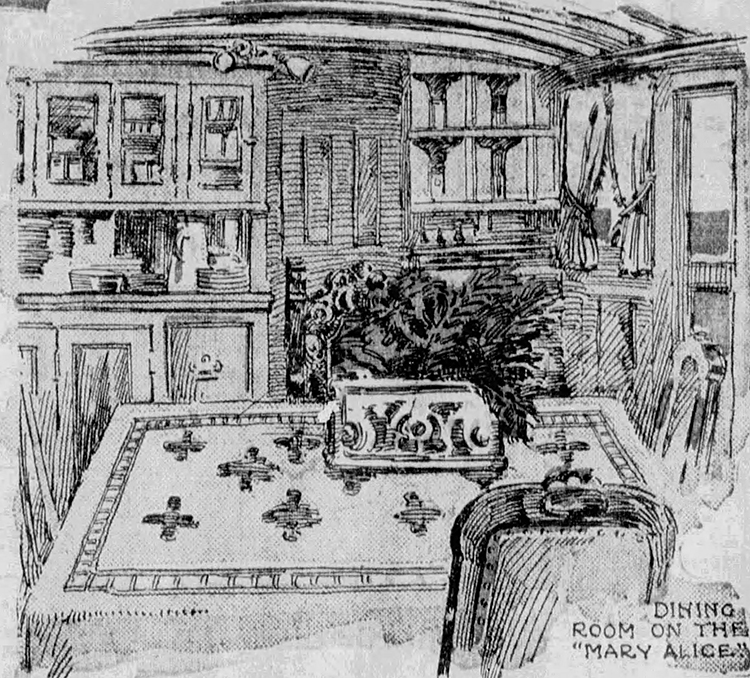 "A color scheme of red and yellow is used in the dining room. All of the wainscoting and upper works is in dark mahogany with a golden yellow trimming used in the small spaces between. On the table is a heavy yellow damask tablecloth in the center of which reposes a large box of fernery. Leather upholstered chairs are used in the dining room. At one end of the room is located a system of mahogany cabinets protected by glass doors. Here are stored dishes, silverware and table linen. At the other end of the room is a large tapestry covered settee, covered with a number of sofa cushions. This room is off the main deck forward and light from eight large windows permits the diners to look out upon the lake while at the table.
"A color scheme of red and yellow is used in the dining room. All of the wainscoting and upper works is in dark mahogany with a golden yellow trimming used in the small spaces between. On the table is a heavy yellow damask tablecloth in the center of which reposes a large box of fernery. Leather upholstered chairs are used in the dining room. At one end of the room is located a system of mahogany cabinets protected by glass doors. Here are stored dishes, silverware and table linen. At the other end of the room is a large tapestry covered settee, covered with a number of sofa cushions. This room is off the main deck forward and light from eight large windows permits the diners to look out upon the lake while at the table.
"Aboard the Mary Alice are two chefs and two waiters, part of the crew of 17 men. The dining room will accomodate 14 guests at one time. A short hallway separates the dining room from the kitchen, making convenient the dining room service.
"In the sleeping compartments of the Mary Alice, which are downstairs, there are six large and roomy staterooms, containing single and double berths. There are two full-size bathrooms aboard. Here, as in the dining and lounging rooms, the woodwork is mahogany. In each of the bedrooms there is hot and cold running water and all the modern conveniences to make comfortable the traveler on a long journey.
"Out on the main deck in the stern of the boat is a long, wide space, carpeted, which is large enough to dance in. Along the upper rail of the deck are strung a great number of red, white and blue electric lights, which are switched on at night, thus illuminating the deck, as well as the ship. All told there were over 1,000 of these colored lights, which extend from the tip of the bow to the stern up over the two mastheads. Also there is a row of lights along the edge of the upper deck. At night when the Mary Alice is far out in the lake she is one mass of colored illumination. At the different lake ports where she has been seen in connection with the Perry Centennial her illumination has drawn considerable favorable comment.
"Her crew is busy most of the time keeping her white hull coverend with paint and the brass work in a high state of polish."
When war in Europe broke out in the summer of 1914, there was little concern in the United States about American participation. Summer cruises around the Great Lakes by the steam yacht owners continued. Mr. Conners' passion for speed continued; he bragged that he outran a sudden storm at 18.5 knots per hour. He also had the coal-burning steam power plant upgraded to the more modern oil-fired plant. (Although the two steam yachts featured here were designed with sailing masts, these were mostly for aesthetic purposes. Engine power was the primary mode of transportation.)
Then, on April 6, 1917, the United States declared war on Germany and its allies. Two weeks later, Spencer Kellogg offered the Elgrudor to the U.S. Navy and Conners followed with the Mary Alice. Both were accepted and fitted out for service with what was called the "mosquito fleet," small, fast boats destined for lake or coastal patrol. Hundreds were already leased or purchased by February ,1917. Sumptuous furnishings were removed, and a three-inch gun and possibly a one-pounder were installed. The fitting out took a "considerable time," according to Buffalo man, Robert G. Ftizbpatrick, who served as a first-class fireman aboard the former Mary Alice, renamed "U.S.S. Mary Alice, S.P. 397 [Submarine Patrol]. The refitting took place in Brooklyn.
The Elgrudor spent the war patrolling the Great Lakes and saw no action. It was manned by a combination of volunteer and Navy personnel. After the war, Mr. Kellogg sold it in 1920, retiring from yachting permanently. After being sold again, the Elgrudor burned in 1925 in New York City.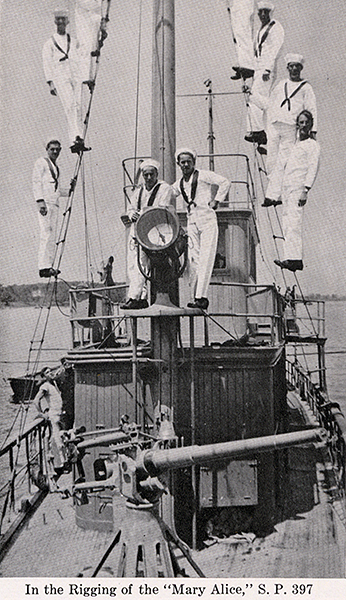
The Mary Alice had another fate. She was assigned to coastal submarine patrol at White Stone Landing in New York to prevent submarines from entering the Hudson River. She also escorted convoys for 100 - 200 miles out to sea before turning back.
On October 5, 1918, the Mary Alice was assigned to accompany a newly completed submarine out for a test dive that required the sub to submerge to 200 feet; if it passed, the government would accept it (and each sailor onboard would receive $100).
The submarine made the dive and surfaced beneath the Mary Alice, amidship. The Mary Alice sank in 8 minutes, but all the sailors aboard were saved. Fireman Fitzgerald was the last man off the boat, having stayed to shut off the fires and prevent the boat from exploding. He found himself without a lifebelt or access to the one lifeboat that had been able to launch and so he was in the water for nearly two hours, clinging to a plank in 20 foot seas. He was hospitalized until December, 1918, when he was discharged from the Navy, with an exciting story to tell.
News of the sinking traveled swiftly to Buffalo. Mr. Conners said the next day, "That is too bad. I am very sorry to hear that the good ship went that way, for I had been hoping she might get a submarine or two. She was a mightly good yacht and I enjoyed many a good cruise aboard her."
The Mary Alice was constructed at a cost of $250,000 in 1897; that is equivalent to $9,016,622 in today's dollars.
World War 1 saw the beginning of the end for the millionaire toys that were steam yachts. By the second World War, the last of them disappeared in the war effort.